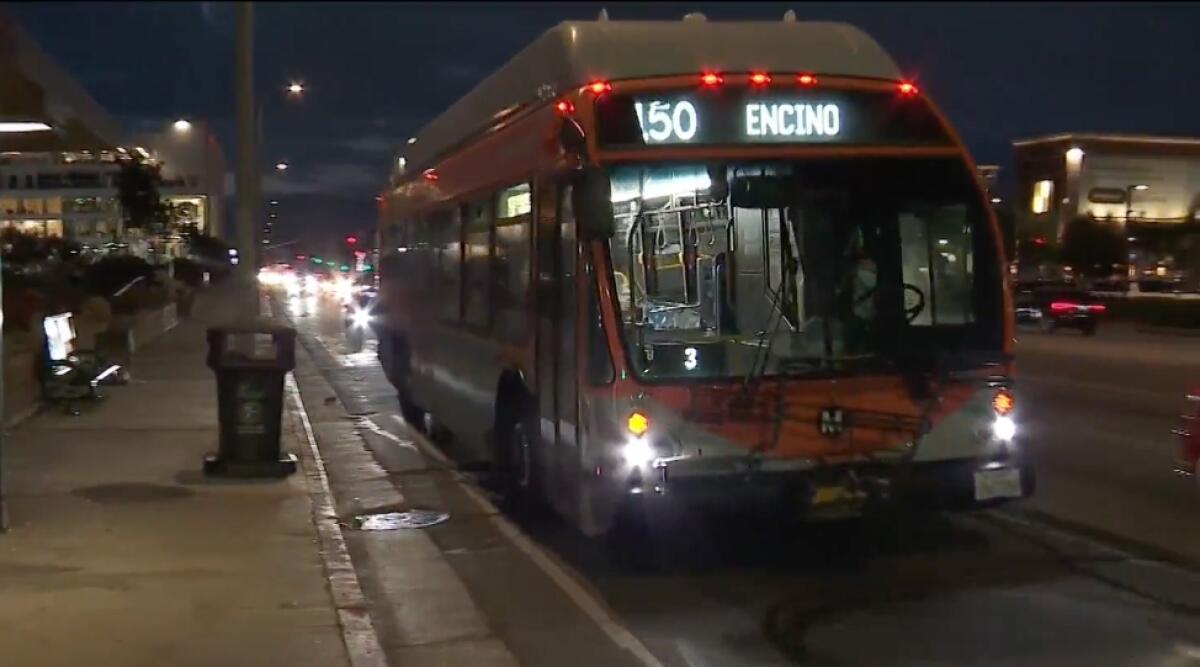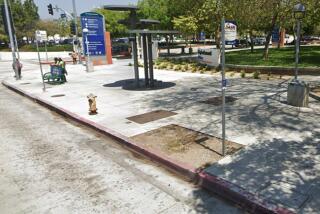‘Help me, help me’: Metro bus driver stabbed, reviving fears about safety

A video circulating on social media captured the moments a bus driver was stabbed Saturday night by a passenger in Willowbrook as other passengers watched.
The driver survived and is recovering at home, but the incident heightens concern about the safety of Metro’s bus drivers and passengers. The attack came less 24 hours after an argument among passengers resulted in the stabbing of a 70-year-old man on a bus in Silver Lake and less than a month after another man hijacked and crashed a bus in downtown Los Angeles.
Metro’s head of security, who was recently fired after filing a complaint to the agency’s inspector general, says that law enforcement isn’t doing enough to prosecute those responsible for such crimes, and the local union representing drivers said they are worried about their members’ safety.
“It has got to stop, it has got to stop,” said John Ellis, who represents six union locals that account for 5,000 bus and rail operators working at Los Angeles County Metropolitan Transportation Authority. “There are people that are afraid to go to work.”
Ellis has been working with Metro to produce a fully encased protective barrier that could prevent attacks such as this one, but he says the process has taken too long.
“There’s a lot of red tape and some of that can be eliminated,” he said.
As Metro ridership has gone up, so too has the number of assaults on its bus and train operators — 168 in 2023, a slight increase from the previous year. The assaults included being spat on and being stabbed.
The figures underscore a stark national trend. Assaults on transit workers have tripled over the last 15 years, according to research from the Urban Institute, making it more difficult for public agencies to recruit and retain their workers.
“It’s devastating,” said Lindiwe Rennert, a senior researcher associate at the think tank. “To go into a work environment where you are fearful for your well-being. No one should have to deal with that, especially someone who is a public servant.”
Rennert reviewed federal data between 2008 and 2022 and found the number of assaults resulting in deaths or medical transport rose to 492 from 168 nationwide.
Among transit agencies Metro had the sixth highest number of assaults, she said. The nation’s busiest transit agency, in New York, topped the list. What Rennert found when she compared economic and social variables, was that there was a statistically significant relationship between assaults on transit workers and both income inequality and civil unrest.
Eliminating fares could help ease the stresses, she said. But Rennert warns against flooding areas with law enforcement, a move that often temporarily reduces crime but doesn’t provide a long-term solution.
“You will see see drops in assault counts in spaces where cops and law enforcement are momentarily, and then when they are gone, the counts spike right back up,” she said.
What the limited federal data didn’t capture was the extent of violence or battery exacted on transit workers. New standards that will require agencies to report a wider range of assaults should illuminate that in the coming year.
In Los Angeles, a log of assaults on bus and rail operators, regularly presented to the Metro board, details some of the abuse bus drivers endure.
In January alone, a man attempted to rape a bus driver in Culver City; a passenger bit a bus driver because they didn’t stop and then pepper- sprayed security in El Monte ; and on 7th and Alvarado streets a bus driver got into an altercation with a passenger after asking the person to stop cursing near a woman and her small children. The man swung at the driver several times, before the driver got him in a headlock and punched him. The suspect bit the driver on the chest and fled.
“These are hyperviolent examples but unfortunately it is par for the course,” Rennert said. “Sexual assaults and stabbings are the types of assaults we hear about nationwide.”
Metro’s recently fired chief of safety and security officer, Gina Osborn, a former FBI agent, has been critical of law enforcement agencies contracted with Metro. According to her calculations, the Los Angeles Police Department and the county Sheriff’s Department have presented fewer than 30% of the assault cases to the district attorney or city attorney, despite having cameras on buses.
“That to me is the most egregious,” Osborn said. “There’s no coordination, there’s no collaboration, there’s no searching to make sure that this person isn’t coming back tomorrow.”
She pointed to the hijacking in downtown L.A. last month, where a man armed with an airsoft gun forced the driver to steer the bus to several locations before crashing into the Ritz-Carlton hotel. When she asked law enforcement officers whether the suspect was the same person as one in a similar incident the week before, she said, they didn’t know.
LAPD Deputy Chief Donald Graham, who oversees the Transit Services Bureau, said Osborn fails to understand the intricacies of local policing agencies, including which cases are prosecuted and on what charges. He said he expects his team to present a case to prosecutors every time there is an arrest.
He points out that as of Sunday, Part 1 crimes — including homicides, violent assaults and robberies — on buses, trains and stations are down 41% so far this year in areas patrolled by LAPD compared with the same period in the previous year.
He said the agency is increasingly working with other law enforcement agencies, Metro security and ambassadors to identify suspects. Weapons- and narcotics-related arrests have surged, and since Jan. 1 in the transit system, the LAPD has arrested 904 people for trespassing — often for not carrying a TAP card needed to board trains or buses.
Capt. Shawn R. Kehoe of the Sheriff’s Transit Services Bureau, said the Sheriff’s Department solved and filed with the district attorney’s office 15 of the 54 bus driver assaults reported in its jurisdiction last year.
“Our current clearance rate is 27%,” he said. “We take every crime seriously. Our Transit Services Bureau detectives are assigned solely to investigate public transit crimes and investigate each crime to the fullest extent possible using all available resources.”
Metro’s executive board has been grappling with issues of policing on thousands of Metro buses, trains and stations for years. Whereas social justice activists are calling for the board to decrease the number of armed officers, employees are worried about safety. The cost of contracting with law enforcement has been ballooning, and Metro has been weighing whether to create its own police force.
Osborn, who backs the idea of a Metro-run police agency, acknowledges that prosecutions might have done little to deter the latest attack. But she said there’s a general malaise when it comes to policing transit.
Since last year, Metro has increased the number of security officers to patrol the buses on lines where there has been an assault. Law enforcement agencies also have dedicated units assigned to patrol buses.
The driver stabbed Saturday night has been with the agency since 2022.
Deputies who reviewed video from the bus identified Darnell M. Bray as a possible supsect. The 30-year-old was released from prison last year after serving 16 years for carjacking, robbery and kidnapping and had been in violation of his parole.
“We don’t want anything else to happen to any other bus driver,” said Sheriff’s Det. Mathew Fraijo, who is investigating the case and has asked for the public’s help in locating Bray.
A video from a passenger at the back of the bus on Line 53 was posted on Instagram and Facebook this week.
For most of the recording, the camera is pointed to the floor but the confrontation can be heard.
“Get off the bus,” the suspect demands before taunting the driver. “Are you scared, bro?”
There’s a commotion. Then the bus driver begs for mercy.
“Sorry, sorry, sorry. Sorry. Sorry,” he says. Then he bursts out in a cry. He was punched in the face with brass knuckles and then stabbed in the chest, according to Fraijo. “Help me, help me, help me, help me!” he wails.
The short video clip suddenly ends, as the passenger taking the video escapes out a back door. Fraijo said the attacker fled down the street and the driver got out of the bus and went looking for help in the other direction.
A good Samaritan picked him up and took him to Martin Luther King Jr. Community Hospital. The driver, who has not been identified, is now recovering at home.
“Metro is saddened to hear about this senseless act of violence against our bus operator, which was apparently fueled by drug abuse and untreated mental illness — crises that are plaguing our nation,” said Metro spokesman Jose Ubaldo.
Fraijo said the suspect is being sought for attempted murder and a potential hate crime.
When the attacker, who is Black, first boarded the the bus a block or two earlier, Fraijo said, he had been ranting about how people like the bus driver, who is Latino, were taking away “their jobs.”
More to Read
Sign up for Essential California
The most important California stories and recommendations in your inbox every morning.
You may occasionally receive promotional content from the Los Angeles Times.










